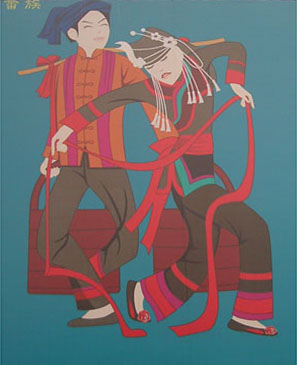She people
She people are an ethnic group living primarily in the southeastern provinces of China, including Fujian, Zhejiang, Jiangxi, and Guangdong. They are recognized as one of the 56 ethnic groups officially identified by the People's Republic of China. The She people are known for their rich cultural heritage, which includes unique traditions, languages, and festivals. Their population is estimated to be around 700,000, making them one of the smaller ethnic minorities in China.
History[edit | edit source]
The history of the She people dates back thousands of years. They are believed to be descendants of the ancient Yue people, who lived in southern China. Over centuries, the She people have migrated and settled in their current locations. Historically, they have engaged in agriculture, forestry, and the cultivation of tea. The She people have also been known for their resistance against various ruling dynasties in China, striving to preserve their culture and autonomy.
Language[edit | edit source]
The She people speak the She language, which belongs to the Hmong-Mien language family. However, due to their close proximity to the Han Chinese, many She people also speak local dialects of the Chinese language, such as Hakka and Min. The She language is facing challenges of language preservation, as more She people adopt Mandarin or other local Chinese dialects as their primary language.
Culture[edit | edit source]
The culture of the She people is rich and diverse. They are known for their traditional music, dance, and handicrafts. The She people celebrate various festivals, with the most notable being the She Nationality Fire Festival, which is celebrated to pray for good health and harvests. Traditional She music often features unique instruments, such as the lusheng, a type of bamboo pipe.
Clothing is another significant aspect of She culture, with traditional attire often being colorful and elaborately decorated. Women's clothing, in particular, is known for its intricate embroidery, which is a skill passed down through generations.
Religion[edit | edit source]
The She people practice a form of animism, worshipping natural elements and ancestors. They believe in the presence of spirits in nature and conduct various rituals and ceremonies to honor these spirits and their ancestors. Buddhism and Taoism have also influenced the religious practices of the She people, incorporating elements of these religions into their traditional beliefs.
Economic Activities[edit | edit source]
Traditionally, the She people have relied on agriculture, particularly the cultivation of tea. The She region is known for producing some of China's famous teas. In addition to agriculture, the She people engage in forestry and the collection of medicinal herbs. In recent years, tourism has become an increasingly important economic activity, as the She people open up their villages to visitors interested in their culture and traditions.
Challenges[edit | edit source]
The She people face several challenges, including economic development, preservation of their language and culture, and integration into broader Chinese society. While efforts are being made to preserve the She language and cultural practices, the influence of mainstream Han Chinese culture and the economic benefits associated with integration pose challenges to these efforts.
Conclusion[edit | edit source]
The She people are an integral part of China's ethnic mosaic, contributing to the country's cultural diversity with their unique traditions, language, and way of life. Efforts to preserve their cultural heritage while navigating the challenges of modernization are crucial for the continued vitality of the She community.
Search WikiMD
Ad.Tired of being Overweight? Try W8MD's NYC physician weight loss.
Semaglutide (Ozempic / Wegovy and Tirzepatide (Mounjaro / Zepbound) available. Call 718 946 5500.
Advertise on WikiMD
|
WikiMD's Wellness Encyclopedia |
| Let Food Be Thy Medicine Medicine Thy Food - Hippocrates |
Translate this page: - East Asian
中文,
日本,
한국어,
South Asian
हिन्दी,
தமிழ்,
తెలుగు,
Urdu,
ಕನ್ನಡ,
Southeast Asian
Indonesian,
Vietnamese,
Thai,
မြန်မာဘာသာ,
বাংলা
European
español,
Deutsch,
français,
Greek,
português do Brasil,
polski,
română,
русский,
Nederlands,
norsk,
svenska,
suomi,
Italian
Middle Eastern & African
عربى,
Turkish,
Persian,
Hebrew,
Afrikaans,
isiZulu,
Kiswahili,
Other
Bulgarian,
Hungarian,
Czech,
Swedish,
മലയാളം,
मराठी,
ਪੰਜਾਬੀ,
ગુજરાતી,
Portuguese,
Ukrainian
Medical Disclaimer: WikiMD is not a substitute for professional medical advice. The information on WikiMD is provided as an information resource only, may be incorrect, outdated or misleading, and is not to be used or relied on for any diagnostic or treatment purposes. Please consult your health care provider before making any healthcare decisions or for guidance about a specific medical condition. WikiMD expressly disclaims responsibility, and shall have no liability, for any damages, loss, injury, or liability whatsoever suffered as a result of your reliance on the information contained in this site. By visiting this site you agree to the foregoing terms and conditions, which may from time to time be changed or supplemented by WikiMD. If you do not agree to the foregoing terms and conditions, you should not enter or use this site. See full disclaimer.
Credits:Most images are courtesy of Wikimedia commons, and templates, categories Wikipedia, licensed under CC BY SA or similar.
Contributors: Prab R. Tumpati, MD




